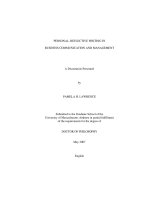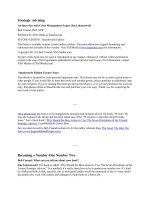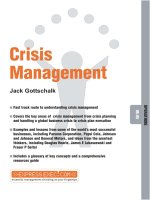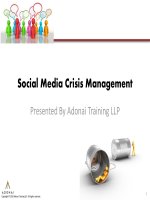communication crisis management
Bạn đang xem bản rút gọn của tài liệu. Xem và tải ngay bản đầy đủ của tài liệu tại đây (1.6 MB, 16 trang )
<span class="text_page_counter">Trang 1</span><div class="page_container" data-page="1">
Nguyen Ngoc Minh Hoai SS160326Nguyen Doan Kim Anh SS160506Nguyen Gia Trung Kien SE150859
</div><span class="text_page_counter">Trang 2</span><div class="page_container" data-page="2">TABLE OF CONTENTS
I. Abstract Introduction... 3
II. Organizational History... 3
III. Risk Assessment... 4
IV. Strategic Communication Action Plan... 6
1. Confidentiality Statement... 6
2. Acknowledgment... 6
3. CMT Contact List...6
4. Incident Report form...8
5. CMT Communication Strategy Worksheet... 8
6. Stakeholder Contact Worksheet...13
7. Secondary Contact List... 15
8. Centralize External Communication... 15
9. Proprietary Information...16
10. Crisis Control Center Designation... 16
V. Evaluation...16
VI. References... 16
</div><span class="text_page_counter">Trang 3</span><div class="page_container" data-page="3">I. Abstract Introduction
This media crisis report was prepared by our team with the aim of clarifyingthe media crisis that Nestle faced in 2010, with heavy criticism coming fromthe online community and organizations. Greenpeace about the Kitkatincident is said to have indirectly supported deforestation for palm oilproduction. This report will include a detailed overview of the incident, and anycorrections, related to the incident. Thereby, planning and handling
communication for the incident based on the knowledge learned in thecommunication crisis management course.
II. Organizational History
Nestlé is a multinational food and beverage company that was founded inSwitzerland in 1866 by Henri Nestlé. Here's a brief overview of Nestlé'sorganizational history: Early Years:
1. The company was initially established as the Anglo-Swiss Condensed MilkCompany, focusing on producing and selling infant formula and milk-basedproducts. Henri Nestlé's development of an innovative infant formula, knownas "Farine lactée," laid the foundation for the company's success.
2. Expansion and Diversification: In the late 19th and early 20th centuries,Nestlé expanded its product offerings beyond infant formula. The companybegan to manufacture condensed milk, powdered milk, chocolate, and otherproducts. It also initiated its international expansion, establishing factories invarious countries across Europe and the United States.
3. Mergers and Acquisitions: Over the years, Nestlé engaged in numerousmergers and acquisitions to expand its market presence and diversify itsproduct portfolio. Some notable acquisitions include the purchase ofPeter-Cailler-Kohler Swiss Chocolate Company (1929), Libby's (1971),Rowntree Mackintosh (1988), Perrier (1992), and Ralston Purina (2002).These acquisitions allowed Nestlé to enter new markets and strengthen itsposition in existing ones.
4. Brand Portfolio: Nestlé owns a vast array of brands covering several food andbeverage categories. Some well-known Nestlé brands include Nescafé,KitKat, Maggi, Nestea, Nesquik, Häagen-Dazs, Purina, Gerber, and manyothers. The company's brand portfolio spans multiple segments, includingcoffee, dairy products, confectionery, pet care, and nutrition.
5. Health and Wellness Focus: In recent years, Nestlé has placed an increasedemphasis on health and wellness. The company has been working towardsreducing salt, sugar, and saturated fats in its products, while alsoincorporating more nutritious ingredients. Nestlé has made commitments toaddress public health challenges, such as childhood obesity, by reformulatingits products and providing healthier choices.
6. Sustainability Initiatives: Nestlé is actively involved in sustainability effortsacross its operations. The company has set several goals related to waterconservation, waste reduction, greenhouse gas emissions, and responsible
</div><span class="text_page_counter">Trang 4</span><div class="page_container" data-page="4">sourcing of raw materials. Nestlé aims to achieve a net-zero carbon footprintby 2050 and has taken steps to promote sustainable farming practices andimprove the livelihoods of farmers in its supply chain.
Today, Nestlé is one of the largest food and beverage companies globally, withoperations in over 180 countries. It continues to innovate, expand its productofferings, and adapt to changing consumer preferences while maintaining a focus onquality, nutrition, and sustainability.
III. Risk Assessment
Priority Risk factors Description Consequence Impact xLikelihood
Responsibility Action toPrevent/Minimize1 Customer
demand aboycott of thebrand
Customers andpartnerssimultaneouslyask their users notto use Nestlérelated items
Sales as well as thenumber ofconsumersdecreasedsignificantly => Thecompany's profitswere reduced andcould not competewith othercompetitors.
SignificantxLikely High
Open a pressconference toclearly explain theabove incident andreassurecustomers andreduce the severityof the incident
2 Customerdemand aboycott of thebrand
Being boycottedby unrelatedparties or socialmedia sites aswell as worseningthe image of thecompany
A declining imagemeans that thecoverage of thecompany's productsis reduced, affectingthe company'sbrand recognition.
SignificantxVery likelyHigh
Open a pressconference toclearly explain theabove incident andreassurecustomers andreduce the severityof the incident
channelsreported onthe aboveincident
Newspapers,social networks oronlinenewspapersreporting on theincident affectedthe reputation
Causing legalstakeholders tojump in, causingbad rumors aboutthe company aswell as reduced itscredibility withcustomers andpartners
Extensive xvery likelyhigh
Use the mostreliable officialnews sites topublish news andcorrections aboutthe company'scase
</div><span class="text_page_counter">Trang 5</span><div class="page_container" data-page="5">4 Investorsstartedleaving thecompany
The company'sinvestors, as wellas shareholders,began to leave forfear of itsreputation beingaffected
Losing the cashflows into thecompany as well aslosing thecompany's businessrelationships
Extensive xvery likelyhigh
Reaching out toinvestors andclarifying theirviews alsoexplains in detailthe problems thatoccur and sitstogether to solvethe problems tocome up with thebest direction forboth parties.
IV. Strategic Communication Action Plan
1. Confidentiality Statement
All data and records related to the incident of a video clip, which was posted onlineand accidentally misinterpreted the Kitkat slogan "Take a break, let's eat Kitkat"followed by the opening scenes. The extraction of palm trees has inadvertentlycreated confusion for public opinion between Nestlé and Greenpeace, which isguaranteed to be confidential. This information will be kept confidential and can onlybe disclosed under the guidance of the Government. privacy policy. No individual isallowed to receive any personal benefit from the disclosure or use of confidentialinformation. We promise to discuss this information only with employees and seniormanagers. related to and affiliated with Nestlé and Greenpeace.
2. Acknowledgment
To all employees at all levels, our company is facing a case related to allegations ofindirectly promoting the exploitation of forests and planting oil palm trees to produceKitKat products. Through the video Nestle Killer posted by Greenpeace organizationon Youtube and the company is receiving a lot of negative reactions from thecommunity. It is important to recognize and accept our responsibility during thiscrisis. We want to remind all of our employees of the importance of being preparedand prepared to face this crisis. This requires serious understanding and compliancewith our rules and policies, including the mandatory reading of the Crisis
Communication Plan (CCP) that the company has prepared. This plan outlines thesteps we will take to manage the crisis, including releasing information andcommunicating with stakeholders and the media. Any individual who fails to complyor discloses inside information will be held accountable. Finally, we hope and want tothank all the staff members who contributed to this crisis preparedness and responseprocess.
</div><span class="text_page_counter">Trang 6</span><div class="page_container" data-page="6">3. CMT Contact List
Title Relevant toCrisis
Expertise How They Can Help ContactInformationJosé
Executive VicePresident ofOperations
Leadership inthe CrisisManagementTeam
Lead in strategic decisionmaking, coordinate withother departments in thecompany, oversee crisismanagement.
Chief ExecutiveOfficer (CEO)
Support crisisplanning,Represent thecompany incommunicationand
communicationwith the public
- Assist in identifying andplanning crisis resolution,making strategicdecisions for thecompany
- Participating in pressconferences,communications,ensuring publicmessages are conveyedaccurately andconsistently.
Strategicmanagementand crisisresponse
- Directing crisismanagement strategies,developing crisiscommunicationstrategies, and makingstrategic decisions.
Ann Taylor Head ofCommunications and PublicRelations
Develop andexecutecommunicationstrategy
- Planning andimplementing
communication activities,interacting with the media- Shaping messages andstatements to conveypublicly to the public.
Elysia <sup>Social Media</sup>Director <sup>Social media</sup>managementand monitoring
Social media,social mediainteractionmanagement
- Support theimplementation ofcommunication activities- Monitor and managesocial media activity, andreact quickly to usercomments.
Ensuringinformationsecurity andsystemrecovery
Ensuring informationsecurity, system recovery,solving problems relatedto information technology.
</div><span class="text_page_counter">Trang 7</span><div class="page_container" data-page="7">Chief FinancialOfficer
Financialmanagementand evaluation
Financialmanagement,financial riskassessment
Financial assessment,financial riskmanagement, makingfinancial decisions forproposed projects.
Orientation andadvice onenvironmentalmanagement
Provide sustainablesolutions, ensurecompliance withenvironmentalregulations, and provideinformation on issuesrelated to wildlifeprotection.
4. Incident Report form
unsustainably. In this video, an officer takes a bite of a Kit Kat and suddenly realizesit's the bloody toe of an orangutan, one of many endangered species due todeforestation for oil palm plantations.
Incident Severity: ModerateImpact on Stakeholders:
Directly adversely affects the reputation and image of the KitKat brand. Customersand consumers react negatively, saying that Nestle is indirectly promoting thedeforestation of palm plantations, which damages many animals and leaves themhomeless, especially orangutans.
Directly affecting the customer's experience, they feel uncomfortable when theyknow that the brand and product they are using are indirectly harming animals.Customers have a bad view or even turn away, or boycott the brand.
Company reputation Sinar Mars: they are accused of improper use of land to growoil palm trees.
</div><span class="text_page_counter">Trang 8</span><div class="page_container" data-page="8">Government of Indonesia: Like the Sinar Mars company operating in Indonesia, thegovernment of this country is responsible for the supervision and management of oilpalm cultivation. Measures should be taken to manage the environment and protectimportant areas, such as those inhabited by orangutans.
Local communities: Deforestation and habitat loss, especially orangutans, directlyaffect local communities living in the affected area. For these communities, the lossof the natural environment also means the loss of livelihoods and future sustainabledevelopment opportunities. The incident caused anger among the locals here.Action taken:
Nestle has actively contacted and exchanged, explained, and proposed Greenpeaceremove the video posted on Youtube.
Waiting for Greenpeace to respond.
5. CMT Communication Strategy Worksheet
a. Stakeholder analysisStakeholder Degree of
● Responsibility to protectwildlife
● The Origin and
Manufacturing Process ofKitKat
● Openly criticize, call forboycott of Nestle, KitKat● Feeling guilty and
obsessed about theproduct after watchingthe video
Greenpeace andanimal protectionorganizations
High ● Conservation of forest
land and wildlife issues <sup>● Outraged, hate</sup>businesses for indirectlyharming wildlife habitatLocal people Medium ● Loss of living
environment and income.
● People can organizedemonstrations, askingNestle to takeresponsibility for theiractions
● More stringent withlicensing companiesexploiting palmplantations
Investors andshareholders
Medium ● Impact of this crisis onNestle's corporate valueand reputation
● Ask Nestle for details onplans and measures toreduce the impact
</div><span class="text_page_counter">Trang 9</span><div class="page_container" data-page="9">● Can withdrawinvestment capital oreven claim losscompensationb. Goal & Objective
Quickly handle, and end the crisis early. Minimize the impact of Nestle's image.Objective
DURING 48-HOURS RESPONSE
● Pull 80% of public opinion andstakeholders to the official page of thebusiness, limit listening to tabloids● Communicate with 100% of employees to
ensure they are informed about thesituation, guide the company's position,and address any concerns or questionsthey may have in 1-4 hours since thecrisis. They need to read as soon as CCPis completed.
● Maintain the image and reputation ofNestle in the mind of 80% of stakeholdersby providing timely answers andproblem-solving within 24 hours aspromised.
● Media management: Proactively engagewith the media to provide accurate andtimely information, address inquiries, andcorrect any misinformation to ensureaccurate reporting.
● Reassure 80% of the public by posting anannouncement that Nestle is aware of theincident and will soon provide an answerwithin 1 hour of the crisis.
● Dramatically calm public opinion by postinga public explanation of the negligence inthe incident within 24 hours of the crisisoccurring
● Respond to all customer complaints within24 hours of receipt
● The successful proposal made
Greenpeace agree to take down the videoor post a correction about the video within48 hours, the sooner the better.
● Removed 60% of major newspapers, andprominent articles on social networks thatcaused a lot of controversy and negativereactions within 48 hours
● Strictly manage internal information flowsand develop a clear and consistentmessage accordingly to avoid situationswhere multiple spokespersons areexpressing conflicting information.
AFTER 48-HOURS RESPONSE
● Regain 80% of the brand's beautiful imagethrough meaningful communication activitiesafter 2 months.
● Maintain vigilant monitoring of the crisissituation, including social media, newscoverage, and stakeholder feedback.
</div><span class="text_page_counter">Trang 10</span><div class="page_container" data-page="10">● Emphasize collaborations with keystakeholders, including environmentalorganizations, local communities,government bodies, and industry partners,and commitment to collective efforts inaddressing the issue.
● Ensure 70% of articles about Nestle's gooddeeds always stand out from the previousnegative information 2 months after the crisis
Guaranteed to extinguish, and settle70% of the problem after 2 months● Maintain good relationships with
Greenpeace, local organizations, andenvironmental organizations…● Forming the image of a Nestle putting
environmental issues as the top concernin 70% of public opinion.
b. Key Messages:Umbrella Message:
Nestle always puts the needs and experience of customers first, wishing to createmore income and jobs for the people of Indonesia's countryside. It is with greatregret that the subjectivity in the study of the extraction and purchase of palm oilindirectly harms the environment. Nestle is committed to being a business thatalways puts the environment and wildlife conservation as a priority concern.Recognizing the impact of the problem, we have learned a great lesson. In the nearfuture, Nestle will actively take useful actions, support the planting and conservationof forests, and support organizations to protect the environment and wildlife to makeup for this unnecessary omission.
To customer:
Nestle sincerely apologizes to its customers for causing frustration during theincident. We always want to bring our customers the best experience and qualityproducts. We will continuously improve our practices and policies to ensure asustainable future for palm oil supplies and improve our products every day. Finally,we would like to express our sincere thanks to our customers who have beeninterested in our products and have always been with us.
To Greenpeace and organizations that protect forests and wildlife:
Firstly, Nestle deeply regrets unintentionally indirectly affecting wildlife habitat. Wealways put the environment first. Because of the subjectivity and lack ofthoroughness in carefully studying the ecological environment of forest land inIndonesia, it indirectly affects the habitat of chimpanzees and other animals. Nestlewill have activities to support the Indonesian forest ecosystem.
We welcome and appreciate the work of the Greenpeace organization because thevideo was a wake-up call for Nestle as well as helped me to know more informationabout the problem of forest ecosystems and endangered wildlife in Vietnam.Indonesia.
The company will organize an urgent meeting and learn more about Sinar Mas inorder to clarify the information and origin and origin of the supplier. If we find anyproblems that really affect wildlife, we are ready to cancel the contract with thiscompany.
We have always been strongly aware of a sustainable lifestyle in harmony withnature and also recognize the seriousness of the loss of forest land.
Finally, Nestle would like to deduct a large part of the revenue from the consumptionof products from KitKat to contribute to the protection of forest land, and afforestation
</div>








